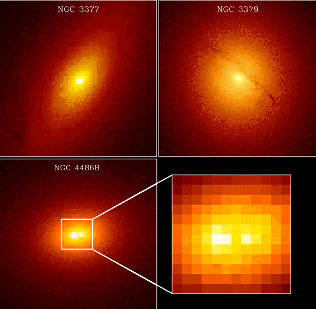This is http://planets.utsc.utoronto.ca/~pawel/glx_grad.html.
This way to the
home page of
Pawel Artymowicz. This way to the home
page of the undergraduate course on galaxies.
The discovery of three black holes in three normal galaxies, NGC 3377,
NGC 3379 And NGC 4486B, suggests nearly all galaxies may harbor supermassive
black holes which once powered quasars but are now quiescent. [Click on
the image to get the whole story.]

GRADUATE COURSE INFORMATION
Title: Galaxies and Galactic Dynamics (5 pts.) course
and term project (4 or 5 p. exercise)
Term: Spring 2003
Lecturer: Pawel Artymowicz (tel 08 55378549, email pawel@astro.su.se)
Times of regular lectures/meetings: Fridays 1pm - 3pm (approximately)
Place: Albanova University Ctr, seminar room, 6th floor.
Term project (4-5 pts): to be submitted anytime before Summer 2003.
Subject
The emphasis of this course is on the theoretical understanding and modeling
of the dynamics of galaxies, including stellar dynamics, dark haloes,
and the spiral structure in gas disks. We will try to make a brief diversion
to observations
by inviting an observer to one of our meetings.
Dates of meetings
The course will be given at Stockholm Observatory starting Jan 24, and
ending in early March 2003.
We will meet for sure once a week for 2 hr, and perhaps occasionally
at other times during the week,
if necessary. Please contact the teacher at any time day/night, e.g.,
if you are stuck with some home problem and start
considering quitting the gradschool.
Format
Listening to lectures will not be the main method of learning. Instead,
we will gain hands-on experience while solving some galactic dynamics problems.
You will have an ample opportunity to solve short sets of theoretical problems.
Some of them will require programming and/or plotting. Skills, such as
Fourier-transforming data and numerically solving equations, will be developed
as an important by-product of the course.
(The formulation, if not solutions, of the assignments/problems is
accessible via this Web page)
You will also have a chance to select one item you like best from a
list of topics for individual study (see below), and to present the results
of a literature search near the end of the course in a 20 min. presentation.
Finally, there will be reading assignments, predominantly from the main
textbook below.
Literature
J. Binney & S. Tremaine "Galactic
Dynamics" (Princeton, 1987 & newer) [main textbook]
Additional books may be used, for instance
J. Binney & M. Merrifield "Galactic
Astronomy" (Princeton, 1999)
and
G. Gilmore, I. King, and van P. van der Kruit (ed. R. Buser) "The
Milky Way as a Galaxy" (University Sci. Boooks, 1990),
plus (don't worry, very few) research papers.
Those who did not go to any undergraduate course in Galaxies are advised
to read Galaxies
& Galactic Structure by Debra M. Elmegreen, or at least some
other
undergraduate-level books from our library.
Getting the "godkänd" credit
The solutions to the above-mentioned problems will be collected at the
time of the lectures, graded, and eventually enter the final evaluation
with a high coefficient. Please keep a xerox copy of your solutions.
Late submissions generate fewer points.
It is expected that all the students produce at least 2/3 of correct
problem solutions (and on certain time scale). Then there will be NO final
exam. Additional problem(s) and/or an informal oral exam will be necessary
if you do not exhibit expected activity during the course, especially if
you did not take the undergraduate course on galactic dynamics at our institute,
and/or lack the knowledge of some important subject normally studied at
the undergraduate level.
Topics for a thorough self-study and presentation
The results of literature search and self-study are to be presented as
a mini-seminar (~20 min) at the end of the course. For general orientation,
ten
days prior to the seminar, one review paper should be suggested for reading
to the other students, who must read it and list at least 3 questions resulting
from their reading. Please avoid the common error of going over time;
you won't be very popular with the students or the teacher, as well as
all your future listners at seminars etc. These topics are proposed, but
may still change during the course:
Nuclear disks in the Galactic Center and other galaxies including AGNs.
Properties of the inferred black holes, new examples.
Do we live in a barred galaxy? In one disk or two disks (the thin and the
thick)? Recent studies of the shape and components of the Milky Way.
Are galaxies transparent or opaque? The issue of internal dust absorption
in disk galaxies.
Current topics in the dynamics of spiral waves. Spiral structure: waves
or modes?
Polar rings around galaxies: stable or transient structures?
Galaxies in the early universe vs. today. The implications of HST images,
in particular Hubble Deep Fields.
Mergers of galaxies: an in-depth review of issues and methods.
The non-conformist galaxies: counter-rotating disks, leading spirals.
Any other topic proposed by you and judged appropriate by the lecturer.
Could be based on a book from our lib.
Latex is great for writing up those great solutions of yours (esp. those
which you are sure of!)
Here is the the on-line
help for LaTeX. Hand-written work is acceptable, if readable by the
teacher.
Galactic Dynamics Exercise (TERM PROJECT)
Accompanying the course, there is an optional exercise or mini-project.
(It is expected that the participants will complete it by early Summer
2003. In fact, there are as many as three different projects to choose
from. Please click here
to
find out about the topics.
